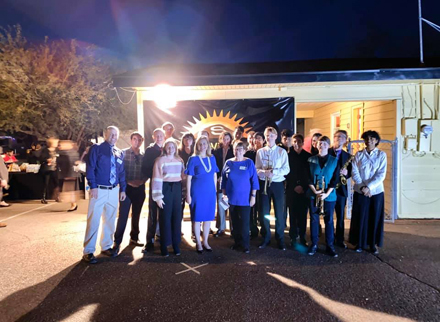
Located just south of the Valley METRO Light Rail on Central Avenue at Pierson Street, the Omninet-West residential development is set to get underway in 2023 (photo courtesy of Data SIO, NOAA, U.S. Navy, NGA, GEBCO Landsat / Copernicus © 2019 Google).
The stretch of Central Avenue from Camelback Road south to Indian School Road is reflective of many of the changes that residents are seeing throughout the city right now.
Going away are Main Street mainstays such as Hinkley’s Lighting, a fixture at Central and Coolidge Street for 70 years, and community gathering spaces, such as Agave Farms, who made their home at Central and Glenrosa Avenue for only 5 years, but whose impact reverberated far beyond its roughly 15-acre plot.
In their place, multi-story residential units are in the works. And these two properties are not alone. In a quick count, there are an estimated 2,800-plus units, mostly deemed “luxury,” either in the planning stages, beginning construction or nearing completion in that one-mile stretch and adjacent. The goal: easing the Phoenix-area housing deficiencies. The hope: that it will fulfill the vision of Reinvent PHX and Transit Oriented Development (TOD).
Some of these developments are including purposeful mixed-use, such as restaurants and retail. Others have included gym amenities that look out on the sidewalk or leasing offices, but little else for new and existing area residents to utilize.
So, is the push for the dense housing units in this area fulfilling the vision and spirit of Reinvent PHX and TOD? The answer generally depends on who you talk to, and it is important to know the history.
Planning-wise, 2015 was a big year for the City of Phoenix. Not only was an updated General Plan adopted by City Council in March and subsequently approved by voters in August of that year, the Long Range Planning Team, in conjunction with other city departments and community partners, was knee-deep in Reinvent PHX and TOD Policy Plans.
In Arizona, cities have a mandate to update and/or readopt a general plan every 10 years by public vote. Reinvent Phoenix, however, was driven by transit. Specifically, METRO Light Rail, which began operating in the Valley in 2008. Reinvent PHX created action plans for five initial districts (two more have been added since) along the light rail system, with a goal to “establish a community-based vision for the future and identify investment strategies to improve the quality of life for all residents.”
TOD is broadly defined as “compact, pedestrian-scaled, mixed use development strategically located within a short walk of high capacity transit” — which intersects with one of the General Plan’s five core values: “Connect People and Places.” Along with the TOD, came the Walkable Urban Code, or WU (Chapter 13 of the Zoning Ordinance).
“The Walkable Urban Code is essentially a design tool to help us to achieve the community vision for those particular areas,” said Joél Carrasco, a member of the Planning Department’s Long Range Planning — Transit Oriented Development team. “It is to support a certain quality of life and balance housing and other uses in a mixed-use environment to support the transit investment of our high-capacity transit system.”
But he is quick to add that the zoning encourages mixed-use, but it is not mandated.
“That’s not to say that there is no opportunity to evaluate that and maybe we can see if there are other ways to encourage our private development community to relook at those spaces [if] they’re not capturing the value that is there.”
Another project that had its beginnings in 2015: Omninet-West, located at Central Avenue and West Pierson Street. It is a challenging location, according to attorney Ed Bull, who represents the developer. Originally zoned as a Planned Unit Development with 286 multi-family units and 14,990 square feet of commercial/retail space, the 3.53 gross-acre project has faced numerous setbacks. It finally gained momentum this year and received preliminary site plan approval in April. But those plans offered a drastically reduced square footage for commercial/retail, 3,125, with around 237 studio, 1-and 2-bedroom units.
In August, the company also requested adding a stipulation that would add another year to its seven-year timeframe to begin construction, which was approved by the Planning Hearing Officer (PHO). This did not sit well with some neighbors.
Without intervention, “Central Avenue will be transformed to a soulless zombie corridor of primarily cookie-cutter residential projects,” said Ken Waters, an area resident. Calling the current development trend, “a tragic case study in how the Light Rail’s Walkable Urban, Transit Oriented Development promise is all going horribly wrong.”
Waters has lived near the Omninet project site for more than two decades and has been following the progress of other developments along Central. His primary concern is the lack of mixed-use (retail and commercial) in the high-density housing being developed.
“There are opportunities for some of the those smaller-scale retail shops along Central. But right now, it’s just not something that we are mandating,” Carrasco said. “We are encouraging, alongside the community, that if developers can make these work, then we are all for it, and we have the tools to support that with our Walkable Urban Code.”
Waters filed an appeal to the PHO approval. His appeal was heard by the Phoenix Planning Commission Oct. 6 — they voted to grant the developer’s request. Waters’ appeal was then scheduled to be heard by City Council Dec. 7, but Bull intervened.
What turned the tide, Bull said, “was input from neighbors, discussions with city staff and others.”
He advised his client that an increase in the amount of ground floor, non-residential space would be in everyone’s best interest. The developer listened and has reversed course to bring the square footage back to close to that originally proposed.
Bull expressed his hopes that neighbors would support the retailers, “If the retail goes in, I hope they, in fact, shop there, because that’s been a challenge for ground-floor retail at these vertical mixed-use developments.”
Positioned at the gateway between Uptown and Midtown, the Omninet-West project has an opportunity to set the tone for subsequent development along this stretch of Central Avenue by activating its streetside spaces with vibrant retail and commercial, showcasing all that this North Central corridor has to offer. For now, all sides of the development seem satisfied, and construction will begin in 2023.
As far as the future of Central Avenue and other areas along the Light Rail, how does the community further that initial vision of Reinvent PHX?
“Well, one, having the mayor and Council adopt community decisions is a huge step in attracting the type of development and investment that we want to see,” Carrasco said. “But we are learning a lot. We hope to revisit all of these areas together in the next few years. I think there are some lessons learned that we can take from here, that we can apply in other areas and look at things a little bit more holistically at the city level.”
In 2023, the city will once again reach out to residents for their input as they gear up for the 2025 General Plan, which will more fully integrate TOD and help refocus the vision behind Reinvent PHX. But, once again all parties will need to show up to the table, make their voices heard and then invest in that vision.







































